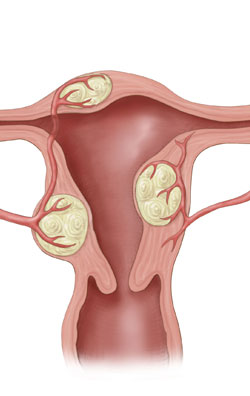
Fibroids also known as leiomyoma are benign growths arising from the muscle layer of the uterus, the myometrium. In many women there are multiple fibroids in the uterus. This condition has no relation with the occurrence of endometrial cancer in the future and the chance of converting of this benign growth to a cancerous growth is very remote.
The muscle layer of the myometrial lining rapidly multiplies and leads to the growth of the rubbery mass (fibroid) in the uterus. The size of the fibroids varies greatly, even in the same person as sometimes the fibroids grow very slowly or not at all or sometimes they grow at a rapid pace. The sizes of the fibroids are also dependent upon the level of circulating hormone leading shrinkage or enlargement.
Uterine fibroids are quite common, affecting 3 out of 4 women at some point of time in their life; however, many of them are unaware of the fibroids as there are no symptoms. If presenting symptoms include heavy bleeding, prolongation of menstrual bleeding, altered bowel movement, increased frequency of urination, etc.
The exact underlying cause of fibroids is not known however common, theories include genetic factors, levels of circulating female hormones and other factors, etc. Family history of fibroid is the most common risk factor associated with it.
Depending upon the size, symptoms, location of the fibroids and desire to conceive, different treatment options are available. Options include regular monitoring, drugs like gonadotrophin releasing hormones, progestin releasing devices, non invasive, minimally invasive and traditional surgical interventions.
Symptoms
In many women, fibroids may not cause any symptom however, if present common symptoms include excessive menstrual bleeding for increased duration, increased cramping pain during bleeding, frequent urination as there is difficulty in urination, constipation, back pain which may radiate to the lower part of the legs, etc.
Under rare circumstances fibroid may lead to a sudden attack of severe pain. It occurs if there is sudden stoppage of blood supply to the fibroid mass as due to twisting of fibroids, which hang from a narrow stalk outside the uterus.
Symptoms may arise depending upon the location and size of the fibroids.
There are mainly three types of fibroids depending upon its location; these are
1. Submucosal: in this type the fibroids hang in the inner cavity of the uterus and heavy and prolonged menstrual bleeding is the most common presenting symptom.
2. Subserosal: in this type the fibroid hang from the outer wall of the uterus and the most common presenting symptoms in these patients arise due to pressure of the fibroids on the adjacent structures. Pressure on the bladder may lead to frequent urination, rectal pressure may lead to constipation and pressure on spinal nerves may lead to back pain.
3. Intramural: in this type the fibroids grow inside the muscle layer only and usually lead to distortion of the shape and size of the uterus.
As such fibroids do not cause any serious complications, but fibroids may interfere with conception or may lead to repeated miscarriages. Heavy blood loss associated with fibroids may lead to anemia.
Causes
Although the exact cause is yet to be identified common theories regarding causation of fibroids include
1. Certain genetic changes as fibroids seem to run in families
2. High level of circulating estrogen and progesterone as fibroids shrink in size after menopause
3. Certain other growth factors like insulin like growth factor promotes growth of fibroids
Risk factors
Common risk factors include family history, being a black women, chronic intake of alcohol, regular consumption of high protein rich and low vegetable containing diet, etc.
Treatment
Depending upon the presenting symptoms, size, desire to get pregnant, etc. different treatment options are available. These include
Regular monitoring: if no significant increase in size occurs and as such symptoms are not bothersome then watchful monitoring is recommended
drugs like gonadotrophin releasing hormones, NSAIDs
intra uterine devices containing progestin
surgery: non invasive, minimally invasive procedures (like myolysis, uterine artery embolisation, etc.) and traditional surgical procedures like hysterectomy or myomectomy





